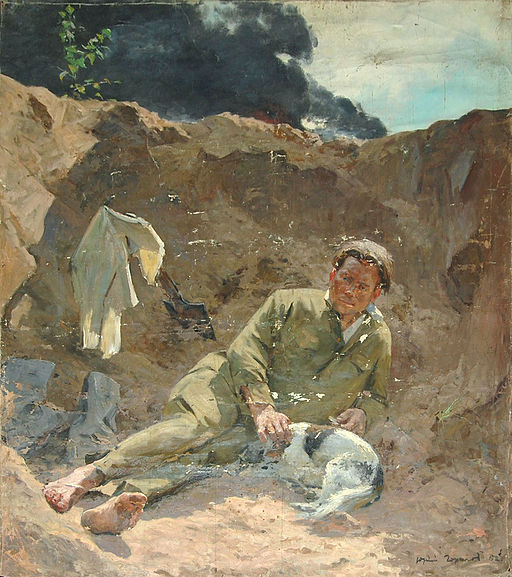aNewDomain — This is a profoundly unpeaceful country. We really like war here, and war movies. Sex and violence sell stories: films, novels, news, magazines. We’re obsessed with it.
In our culture of violence, so violent we aren’t even concerned that the people we have mass-incarcerated are subject to racial violence, gang violence and sexual assault on a daily basis, it seems strange to profess pacifism.
It all stems from a conclusion I reached while working at the state psychiatric hospital.
When I was young, being as strange as I am, I was a natural target for bullies. I was sexually assaulted by older children at the age of six. I did not even realize it was an assault or sexual in nature until much later. That is because I trusted people, I needed to trust others to understand the rules of society. I still do.
Following that, life was a long series of assaults of various natures. People hit me, threatened, teased (which was worse, really). I never defended myself. I couldn’t. I couldn’t work out that the appropriate thing to do was to hit back or run away. So I just stood there.
Once, when I was 10, a bigger boy shoved me and I just stood there. He hit me in the chest and I didn’t move. He wanted to see what it would take to make me react, so he picked me up and set me down in a mud puddle. I came home with wet, dirty feet.
My mum asked what had happened and I told her, and she said, “When someone hits you, you have to hit them back harder. Or they will never stop.”
I never did, and they never stopped. It wasn’t that at 10 years of age I had grasped the moral implications of violence. It was just that I was slow to compute all the social implications. The rules seemed to be that the behaviors I was being bullied for were fine for everyone except me. Other kids weren’t hit for having funny accents. Some of them were celebrated for it. It wasn’t sports or jokes or running …
Non-contingent punishment tends to produce bullies. Antisocial types, drug users, listlessly violent humans. In one more way, I seem to have been lucky.
 But I could never see a way out of these punishments. I was always outnumbered and overmatched, and besides violence never occurred to me.
But I could never see a way out of these punishments. I was always outnumbered and overmatched, and besides violence never occurred to me.
Later, at 15, some children tried to give me “the bumps.” This is a tradition of surrounding another child, holding his or her limbs, and bumping their coccyx against the ground once for every year they are celebrating. For once, I resisted.
The other kids were surprised by the violence of my resistance. Suddenly, I had discovered violence and its worth: I did not get the bumps that day. Because something had changed.
Suddenly, I was tall. Not big, not muscular, but tall.
Not long after I was riding the bus, on the upper deck. A little boy asked his mommy, “Why does that man have long hair?”
I looked around for a man with long hair, taking a minute to realize he meant me. From the child’s perspective, I was a man: Standing there because all the seats were taken, holding onto the support bar, my head brushed the ceiling.
And the attacks against me started to abate.
At 18, walking through an alley on the way to Suffolk College, I was stopped by a male voice from the shadows. He said, “Oy, mate, you have the time?” I looked at my watch (unnecessarily; I always knew the time) and told them. Then I went along my way. Later, I would learn there were thieves in that alley, who distracted victims with that question before jumping them and taking what they had.
They had looked me over, decided not to take me for a victim, passed me over.
Because I was big.
Later still, I was hired to work with people of disability. In that line of work, I learned soft self-defense and containment. People who cannot state or meet their needs are more prone to violent acting out. Our job was to prevent such violence by helping people live good lives, and deflect the violence when it occurred without hurting our charges. Fifteen years of that work took the number of times I had been assaulted into three digits.
Later still, the psychiatric hospital. I thought they hired me as a clinician because of my burgeoning humanistic principles. A colleague suggested they might instead have hired me because I looked like a linebacker. I had never thought of myself before in those terms, started to reflect.
And it occurred to me, finally, after four years at the hospital, that I had been assaulted countless times. But nobody had ever successfully hurt me. Not beyond a bruise or an embarrassment. And I have never hurt anyone else.
And since then, it seems clear to me why we are so violent.
I quit my job as soon as I could. The constant threat of violence filled my mind with concerns of body integrity at a time when I needed to evolve, to be a calm and soothing presence to potential psychotherapy clients. And I listened to police, paramedics, firefighters, other first responders, colleagues at the hospital – all telling their stories of post-traumatic stress. Their own fears of repeated threats to their own body integrity. Stories of first-responders whose PTSD was “cured” who then could not return to their jobs, to the constant violence or threat of it; of soldiers who were “cured” and then could not tolerate redeployment.
And I saw. I saw that we love violence — war, movies, bullies, our police state, tough-on-crime laws and politics — because we are cowards.
We are afraid to be hurt. We are afraid to die. Afraid to give up our power and privilege.
I understand that my ability to be a pacifist depends totally on the fact that I don’t need to be. If I decided to, I could be good at violence. More than a hundred people have tried more than a hundred total times to hurt me. They have tried sincerely and in good faith and they have failed. I have had no reason to be afraid.
Others have been less fortunate. Their non-contingent punishments, their unearned sufferings, have not been redemptive. People embrace violence — punishment for bad people, peace through strength, pre-emptive strikes, unconditional support for cops, laws and soldiers — because they are afraid, because they have good reason to be afraid and this has been demonstrated amply. In their own experiences, through the television news pumping the evidence into their houses day and night.
And here it is: I would rather die than kill. I would rather be hurt than hurt someone.
Other people have not done this math. They look at the void that precedes their lives and that one that must follow it and they see the bright, shining moment in between, and they want to prolong it by any means necessary. If that means violence, if that means striving for safety by surrendering their freedoms, if that means depriving others of that bright light, so be it.
I choose differently. And believe me when I say I have to make that choice constantly. The fear is always with me, too, and the knowledge that I could intimidate or use force to allay that fear. So much temptation. Other people, perhaps, are naturally peaceful. In their hearts, minds, bodies. Souls, if you like. Me, I have to work for it. Work to feel the fear, come to terms with it, let it pass.
I’m not afraid to die or to be hurt. When the moment inspires such fears, I have to remember: my body is afraid, but I am not. I am more than my body, more than adrenaline.
I don’t judge, or at least try not to. Especially troubling to me are people who espouse both faith and violence — and I don’t mean Muslim terrorist groups. But I try not to judge, because faith is not correlated in any way with moral behavior. If we want a more peaceful world, we have to start with ourselves, and with fear.
People are afraid because they have good reason to be. Just as I do. And we use those fears to sell products, books, films, policies, politicians. It’s hard to turn away from the violence and turn towards the people.
Because we can’t look into that void and see that the duration of our light matters very little — only its purity matters. That dying for something matters more than living for nothing, for the sake of staying alive. That survival can be too costly.
For aNewDomain, I’m Jason Dias.
Cover image: Gorelov Y.G. (Family archives) [CC BY-SA 3.0 or GFDL], via Wikimedia Commons












